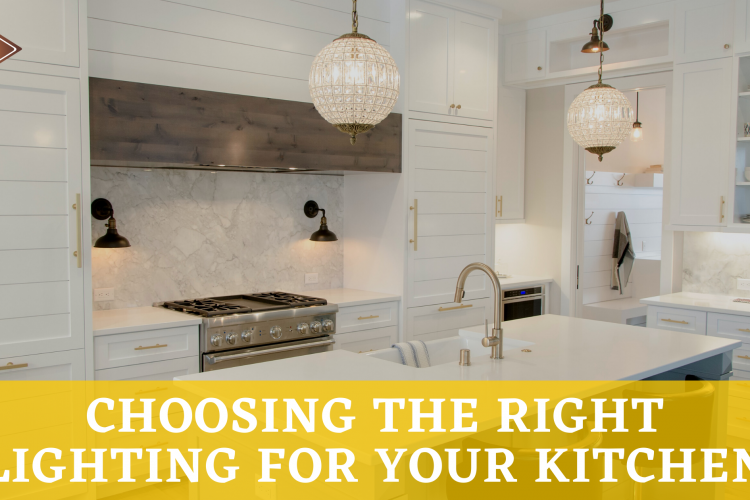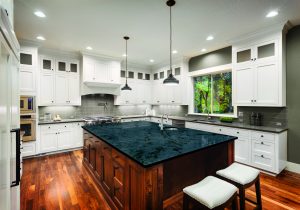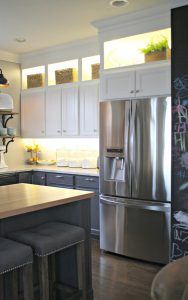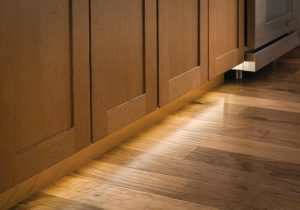
Choosing the Right Lighting for your Kitchen
Choosing the right lighting for your kitchen is extremely important. Even though lighting is one of the most overlooked parts of any room setting. Yet it can play such a pivotal role in setting the tone of the space. Usually when remodeling a kitchen lighting is one of the last pieces considered, after cabinets, countertops, tile, and appliances. However, with the incorrect lighting, space can either be too dark or too bright.
The kitchen is such an important space in most American homes. It is a place for entertainment, a place to complete work for some, along with a place to cook and eat. With so much going on in one room, you need to make sure the lighting is set up properly for any scenario. Your kitchen requires the right balance of lighting to ensure you are prepared for all the activities that may be done in a day.
Types of Lighting
There are three types of lighting that should all be utilized to ensure your kitchen has the best lighting for its design and your needs.
Ambient:
is used to provide, even lighting to the room. This will be your main source of light, that can work in cooperation with or without natural light. You want to evenly distribute as much light as possible to the entire space from your ceiling to make it easy to navigate your entire kitchen. This can be done by using chandeliers, pendant lights, recessed lighting, or flush mounts.
Task:
is the extra lighting needed for very specific tasks to be done efficiently. Task lighting should be used for designated areas such as countertops where you will be preparing food, inside pantries to see what ingredients you are grabbing, over the sink for when you are cleaning dishes, or over any space, you may be doing any work.
Accent:
This lighting is used to ass depth and dimension to the room. Accent lighting can be used to highlight particular parts of the room that you want to draw attention to. Common kitchen accent lights include:
-
Recessed:

This type of refined, out-of-the-way lighting can go anywhere. However, it is particularly important when you want to highlight certain areas of interest in your room, like open shelves and glass cabinets.
-
Over cabinet:

over/under cabinet kitchen lighting
Placed between the cabinet and ceiling, over cabinet lights add a striking touch to your kitchen. Created in a similar fashion to undercabinet lighting, over cabinet lighting can provide even lighting to accent decor and architecture.
- Toe kick Lights:

A great way to distinguish kitchens and to illuminate a pathway. Toe lighting is produced via rope lights or LED tape.
The right accents can truly put the whole room together. While the accents may not be the most important when it comes to giving light, they can put focus on the most important parts of your kitchen.
No layer of lighting can stand alone on its own, each must be used together to ensure proper lighting. Ambient light alone will brighten the room, however certain spots that require additional lighting (I.e above the sink or stove for cleaning and cooking) will be left in the shadows. If only accent lighting is used, you will have a museum effect where particular spots are highlighted but a good portion of the room is left in the dark.
When selecting lighting, use all 3 variations to make sure that your room is lit properly.
Light Bulb Options
The type of bulb will also play a role in how your room will look. There are various types of bulbs that can impact the overall tone of your room based on how they perform. The 4 basic types are incandescent, fluorescent, LED, and halogen bulbs. The traditional incandescent bulbs have been used for years that give off a warm glowing light. Fluorescent bulbs use less energy than incandescent bulbs and last much longer while giving off cooler light tones.
LEDs are similar to fluorescents but with a longer lifespan. Unlike incandescent, they waste barely any energy and are an excellent choice for saving on electricity. As opposed to fluorescent bulbs, they can come in various tones, shades, and color temperatures to avoid problems with bright white light
Like an incandescent bulb, halogen bulbs use a filament to produce light. However, this filament is trapped inside a smaller inner bulb filled with halogen gas. Halogen Bulbs usually last about the same amount of time as incandescent bulbs, about a year or two. They create great high-quality white light, which makes them popular for accent lighting, floodlights, and various types of professional lighting. Due to this bright white light, they tend to burn very hotly which is why they have a much shorter lifespan than LEDs.
Considerations
For most, the kitchen is the heart of the home. It is where you make prepare meals, entertain guests and carious other chores are done. That is why it is important that your kitchen has multiple layers of lighting for every occasion. Think carefully about what color light is best for the kitchen along with the right design, spacing, temperature, and type that will work well with the layout and design of your kitchen.
If you have an open floor plan, it is important to think outside the kitchen as well. Consider how the light fixtures will blend into the other rooms you see from the kitchen. You will probably be spending a lot of time in your kitchen doing many activities so proper lighting will be important.
If you are looking to do more than change the lighting in your kitchen, check out our blog 5 things to know before starting a kitchen remodel.








1 COMMENT
Lorena Ryder
September 11, 2024, 5:25 am REPLYThe way you put together the information on your posts is commendable. I would highly recommend this site. You might also want to check my page <a href="https://www.google.pl/url?sa=t&url=http://46n.de/maryam/kosmetikstudio-mainz">46N</a> for some noteworthy inputs about Cosmetics.